Sylvan Crafts – 10-Sided Die / Polyhedron Assembly
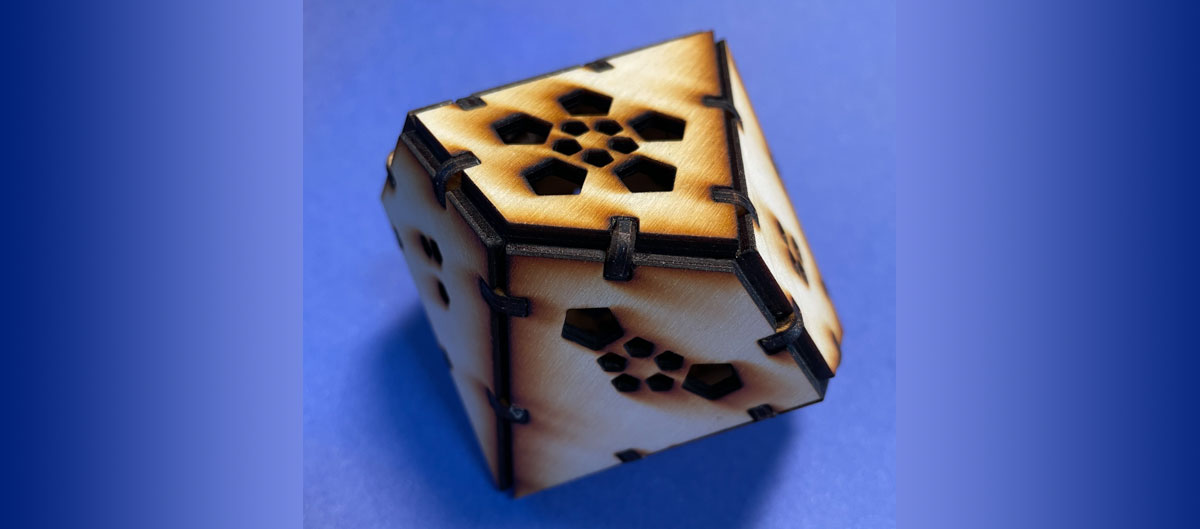
Things to consider before you assemble your Sylvan Crafts kit:
This model was laser cut from natural wood so will have burn marks and scorching. The burns and scorching actually add to the appeal and aesthetics of the wood, so we recommend you assemble your kit with the scorched side of each piece facing outward, for optimal attractiveness.
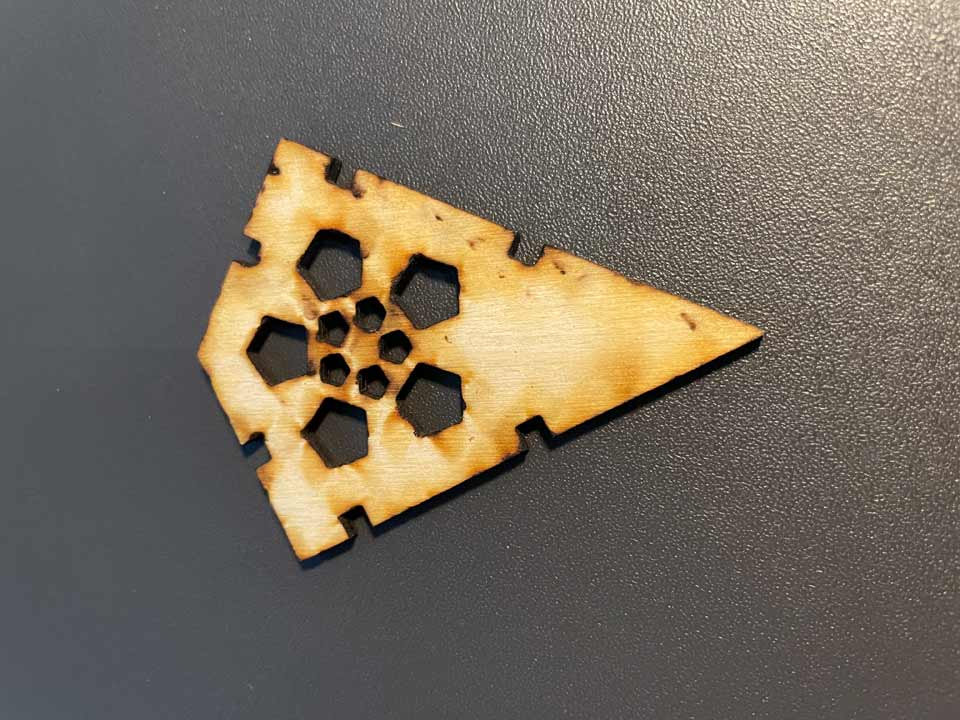
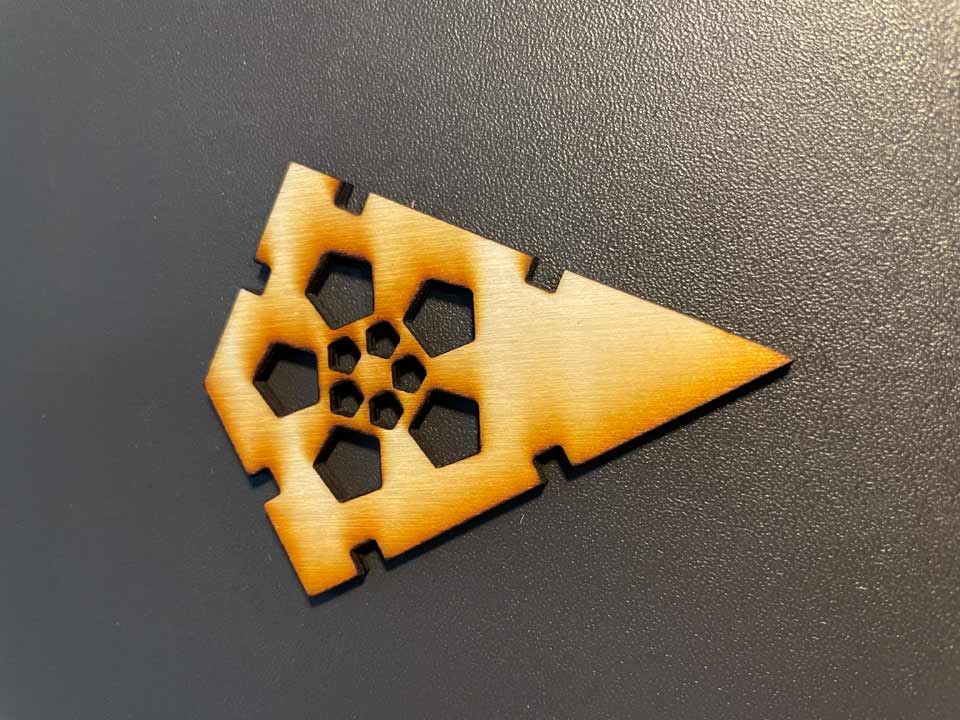
We recommend completing assembly in one sitting; although it is certainly possible to assemble the kit in multiple sessions. Assembling in one sitting allows for you to work while the glue is still a bit flexible, especially if something is slightly out of alignment. A typical first-timer assembly of a kit should take about an hour.
Handy Tip:
Take a quick scroll through all the instructions below to familiarize yourself with the project before starting.Equipment Required:
- A good quality wood glue, such as Titebond/Titebond II (available at any home store). Wood glue will stay flexible as you work with the pieces.
- A craft mat, or some other work surface (not your nana's good dining room table) where you don't have to worry about glue getting on anything. Kitchen parchment paper (used in baking) makes a wonderful work surface when taped flat with painters’ tape.
- A handful of wooden toothpicks for applying glue.
Prepare for Assembly:
There are three types of pieces in this kit:
10 polygon face pieces (4-sided)
20 large mushroom-shaped joint pieces
20 small mushroom-shaped joint pieces (only 10 will be used)
Separate Face Pieces and Joint Pieces From the Board:
- Peel top adhesive layer back carefully – exposing all pieces of the kit. NOTE: Some of the cutouts for the pips (holes in the face pieces) and sprue (junk between joint pieces) may stick to the adhesive paper. This is okay, as long as none of the small joint pieces are accidentally discarded.
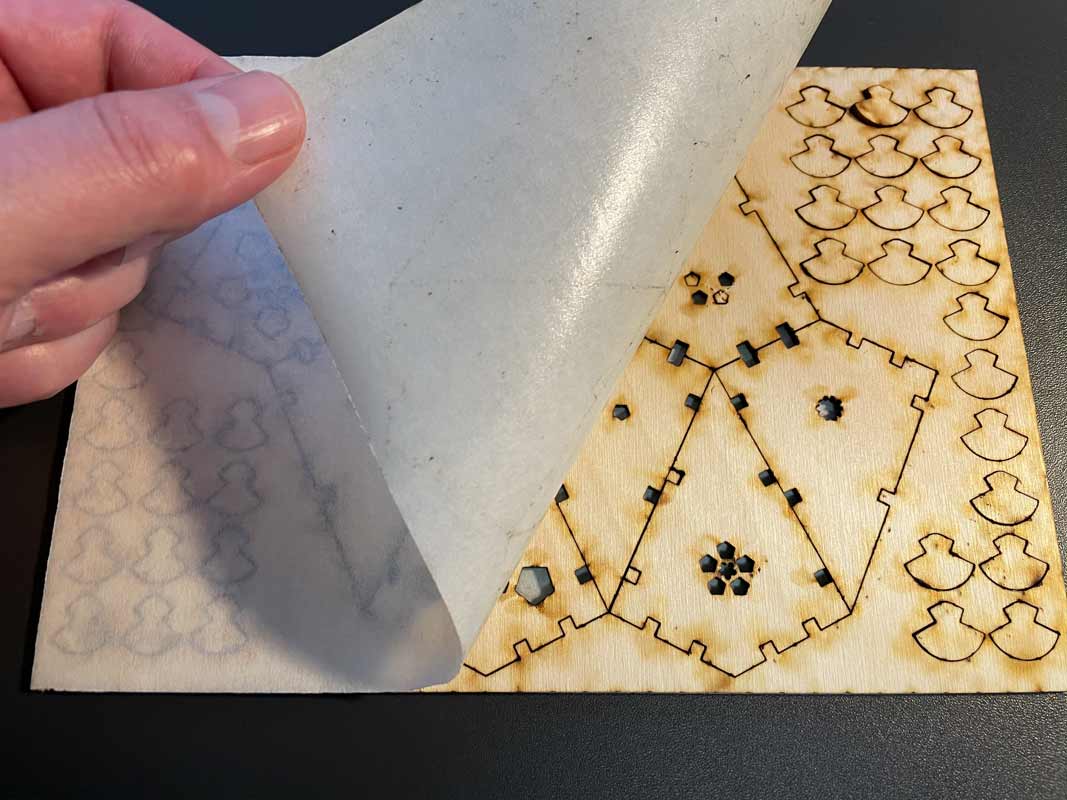
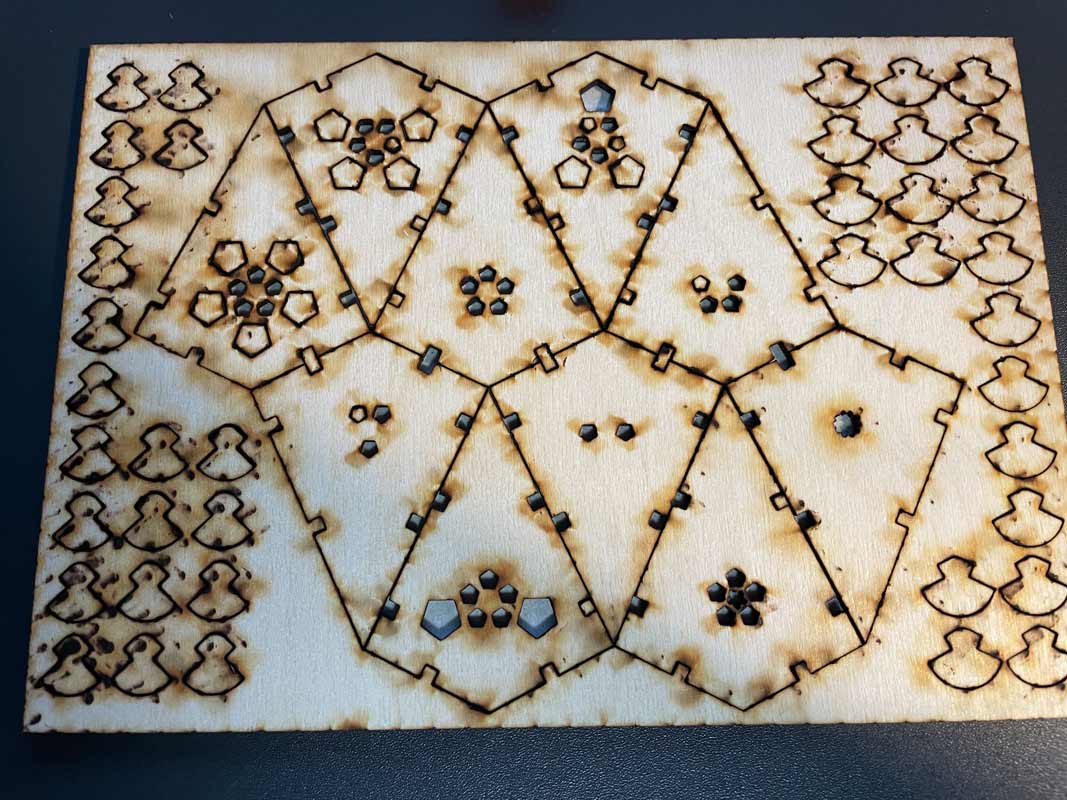
- Carefully remove all 20 large and 20 small joint pieces (the little mushroom looking guys) and place to the side – preferably in a little dish to keep them together. Note: You will only use a total of 10 of the smaller joint pieces, the rest are extra.
- Carefully lift out the 10 polygonal face pieces. You may need to use a toothpick to pop out any cutouts left in the pips of the face pieces. Usually the cutouts will stay stuck to the bottom adhesive paper. Stack the face pieces nearby in numeric order. Once you are sure there are no joint pieces or face pieces left, you can discard the board in your green yard waste recycle bin (adhesive paper and all).
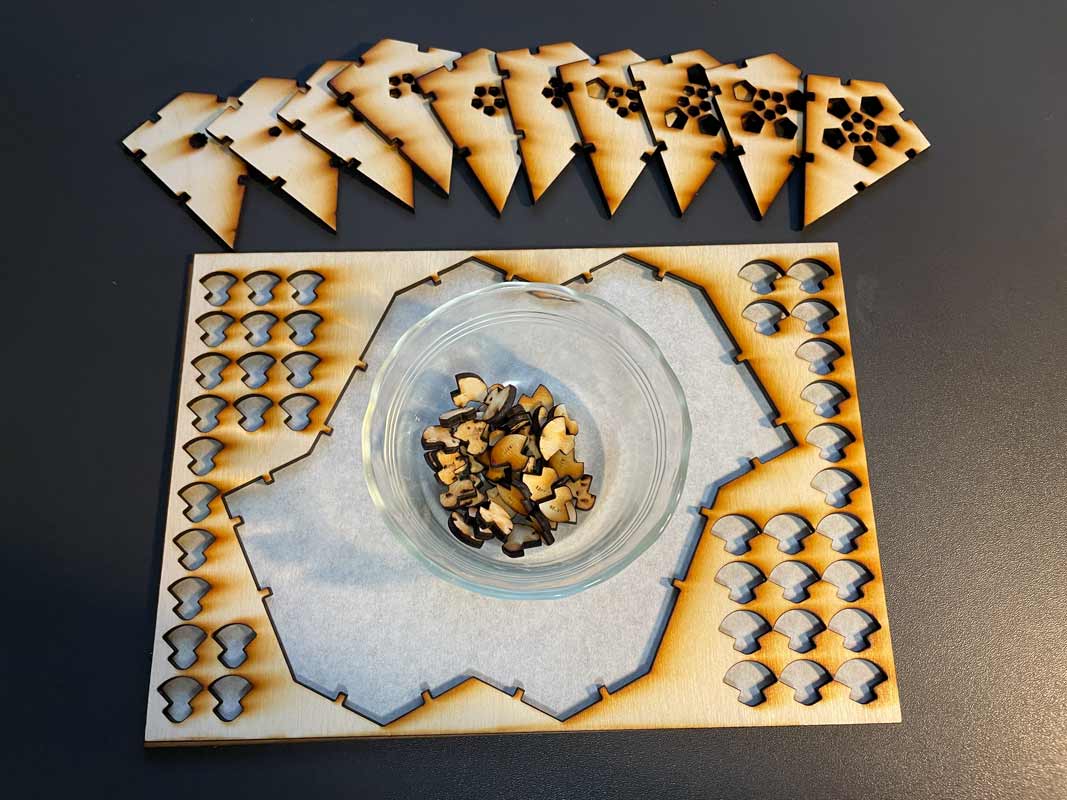
Assembly of First Half:
Put a blob of glue (about the size of a bean) on your work surface so you can easily dip your toothpick into it during assembly. Start a fresh glue puddle as needed.Important:
You will only be adding glue directly to the joint pieces; never to the face pieces themselves. The right way to glue a joint piece is to use a small amount of glue and with your toothpick, just cover the inner edges of one side of a joint piece. See the pink highlighted areas in the image below for where to apply glue.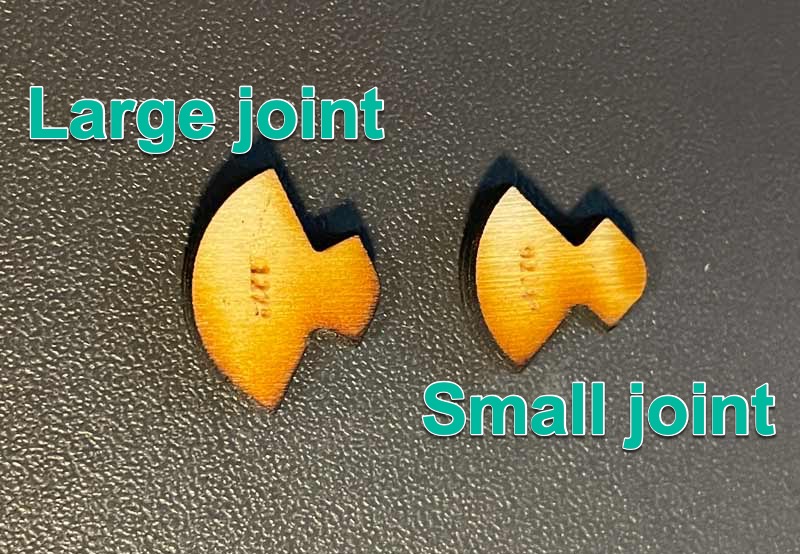

Remember:
Keep the scorched/charred side on the outside of the assembled kit so you can enjoy the beautiful coloration of the wood.Prepping Your First Face Pieces:
- Starting with face piece #10. Flip it over so the pale side is facing up (non charred side) and the engraved circle is facedown. Glue 4 large joint pieces to the #10 face piece as seen in image A below. As the glue begins to dry, snug the joint pieces again against the face piece to ensure they are seated tightly.
- Select face pieces #4 and #6. Glue 2 large joint pieces to the right side edge of each of these face pieces, as seen in image B below.
- Select face piece #8. Glue 2 large joint pieces to the left side edge of this face piece, as seen in image B below.
- Allow the glue to dry for 3 minutes before continuing with the assembly.
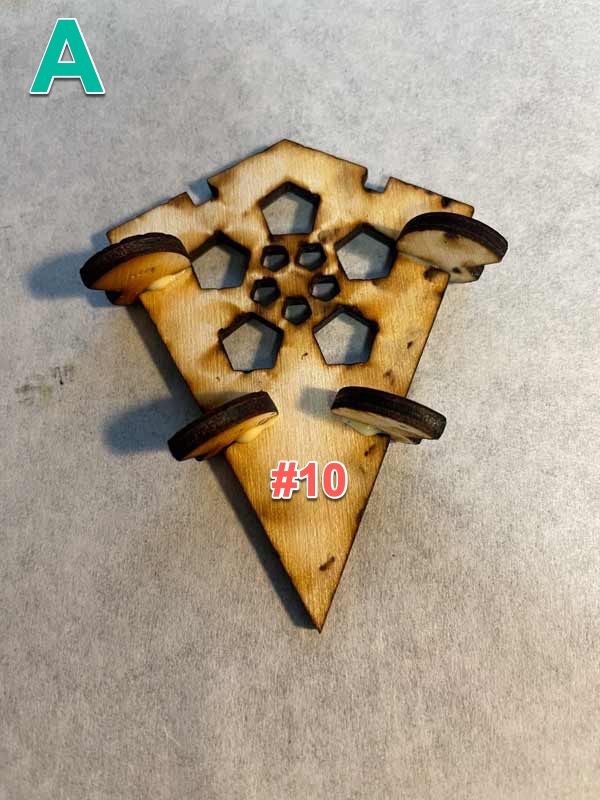
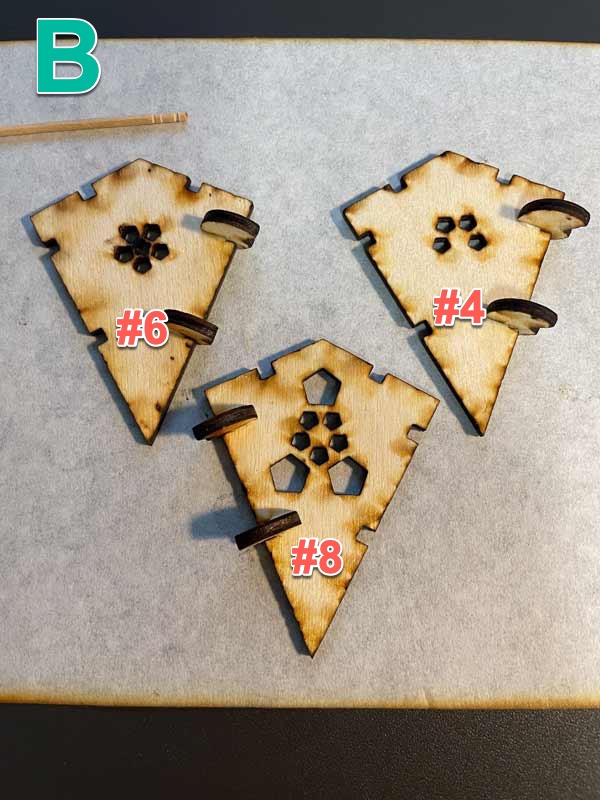
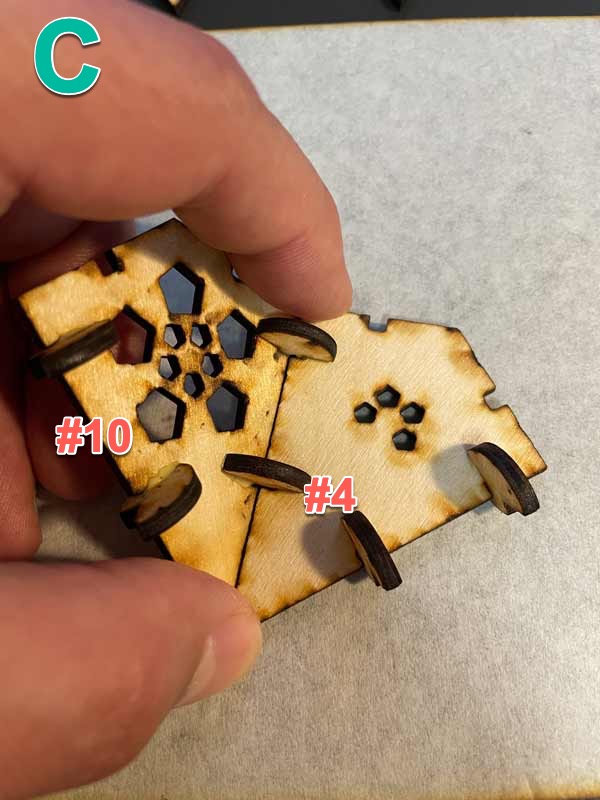
Assembling the First Half:
We will be attaching the five pieces (#2, #4, #6, #8, and #10) you prepared in the last step. These diamond-shaped face pieces will form one half of the 10-sided polyhedron.
- Apply glue to the right side joints of face piece #10. Attach face piece #4 to to #10 as seen in image C above. Laying face piece #4 on your work surface and applying pressure to the joints from face #10 (which has already mostly dried) will make assembly easier (see image D below). Hold your finger in the joint piece against face #4 for 1-2 minutes until set. Allow to dry for 2-3 minutes before continuing.
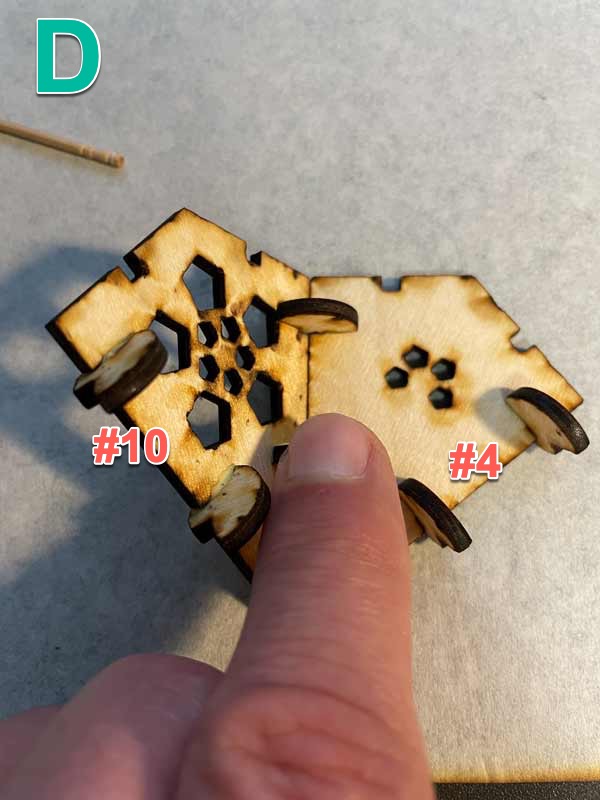
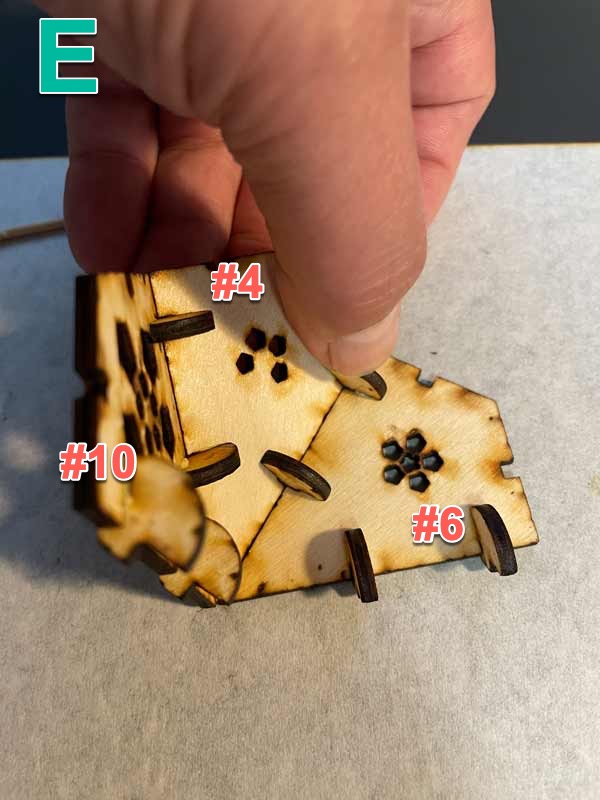
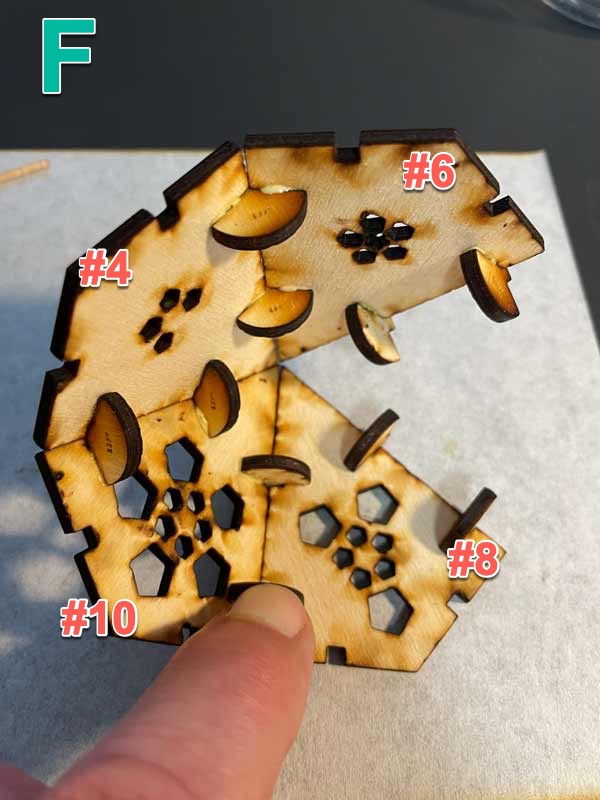
- Apply glue to the 2 joint pices of face piece #4 you just attached. connect face piece #6 to to #4 as seen in image E above. Laying face piece #6 on your work surface and applying pressure to the joint piece of face #4 (which has already mostly dried) will make assembly easier. Hold your fingers on the joint pieces against face #6 for 1-2 minutes until set. Allow to dry for 2-3 minutes before continuing.
- Next, apply glue to the left side joints of face piece #10 on the other side. Attach face piece #8 to to #10 as seen in image F above. Laying face piece #8 on your work surface and applying pressure to the joint piece of face #10 (which is already dry) will make assembly easier. Hold your finger on the joint pieces against face #8 for 1-2 minutes until set. Allow to dry for 2-3 minutes before continuing.
- Pick up your nearly completed half and apply glue to the 4 joint pieces on the #6 and #8 face pieces as seen in image G below. Attach face piece #2 between face pieces #6 and #8 as seen in image H below. Holding the assembled pieces in your hand will allow you to gently cup the pieces together for a snug fit.
- Your final half of the project should look like image I below. Set this completed half aside to fully dry.
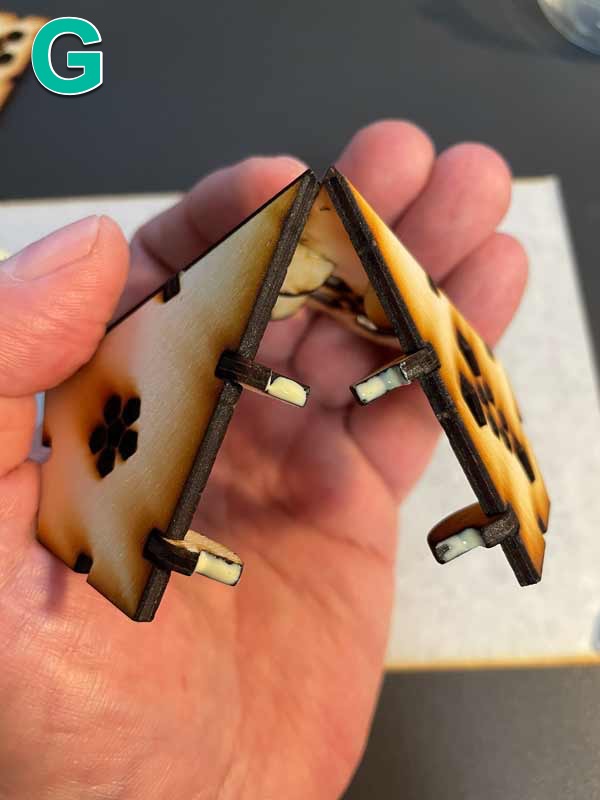
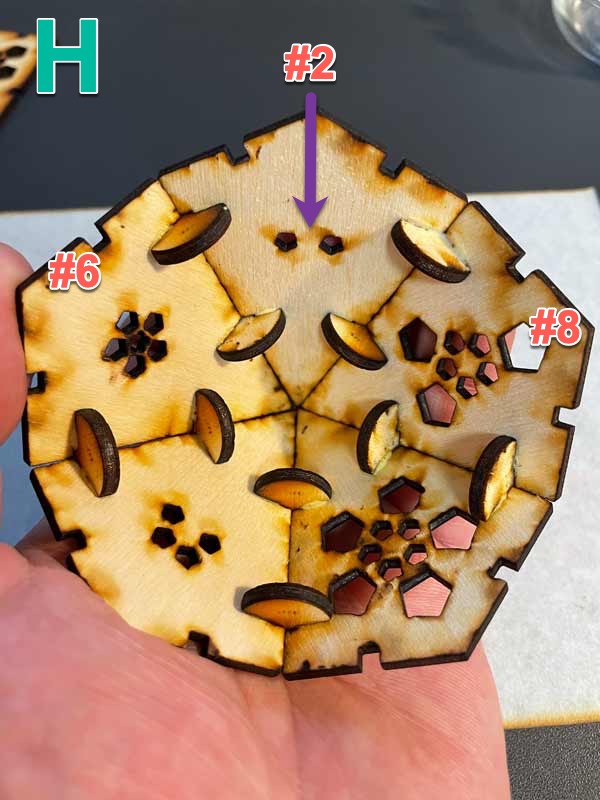
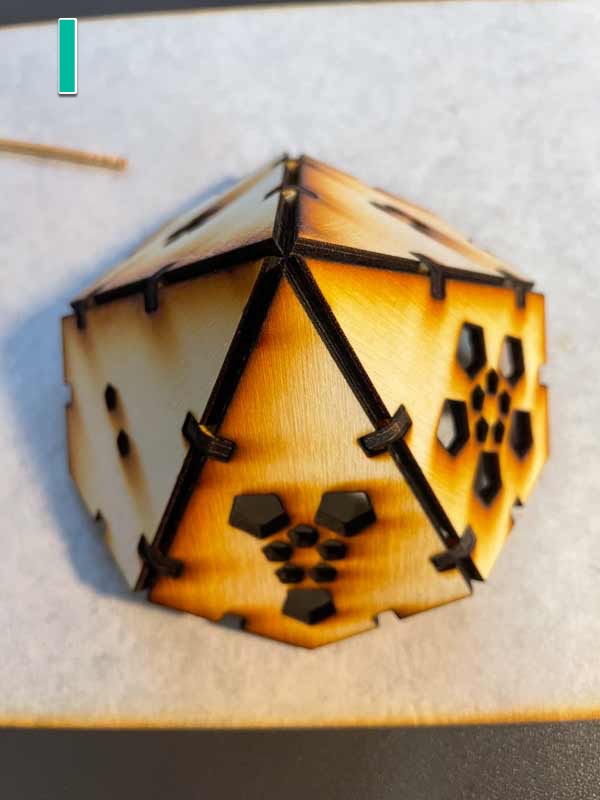
Interesting Fact:
Why is it important what order the faces are glued together? Since this model is a 12-sided die, there is a common layout of sides to assure when thrown, you get the most random value. This is desireable when using this die for gaming.Assembly of Second Half:
Prepping the Second Five Face Pieces:
- Starting with face piece #9. Flip it over so the pale side is facing up (non charred side) and the scorched side is facedown. Glue 4 large joint pieces to the #9 face piece as seen in image J below. As the glue begins to dry, snug the joint pieces again against the face piece to ensure they are seated tightly. Set aside.
- Select face pieces #1 and #7. Glue 2 large joint pieces to the right side edge of each of these face pieces, as seen in image K below.
- Select face piece #5. Glue 2 large joint pieces to the left side edge of this face piece, as seen in image K below.
- Allow 2–3 minutes for glue to dry before continuing.
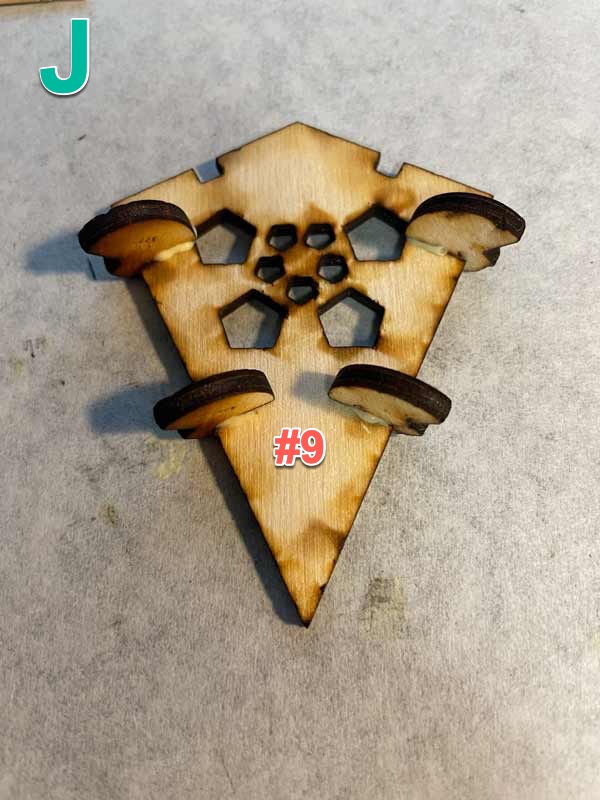
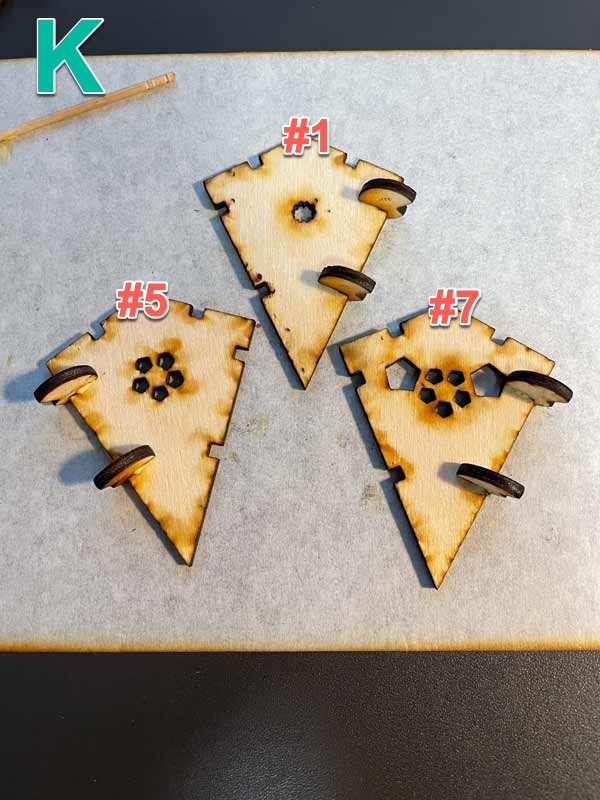
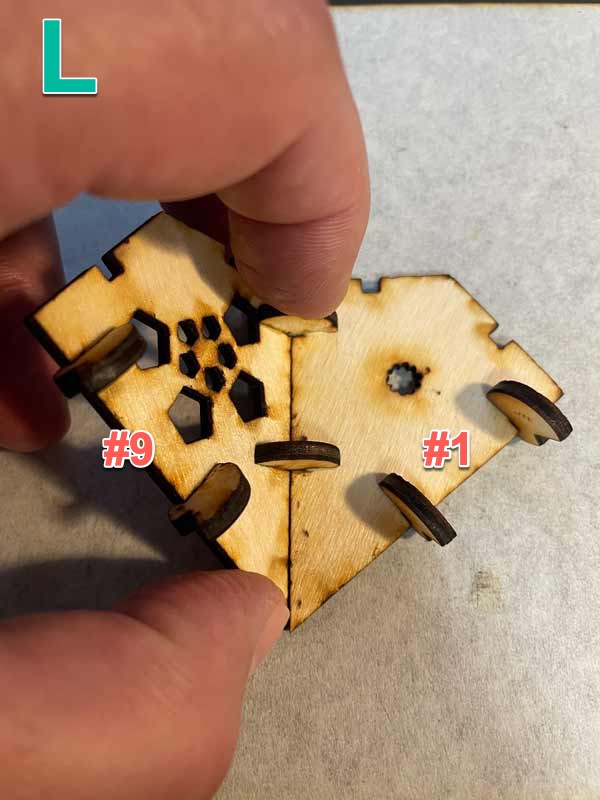
Assembling the Second Five Face Pieces:
We will be attaching the five pieces (#1, #3, #5, #7, and #9) you prepared in the last step. These diamond-shaped face pieces will form the second half the 10-sided polyhedron.
- Apply glue to the right side joint pieces of face piece #9. Attach face piece #1 to to #9 as seen in image L above. Laying face piece #1 on your work surface and applying pressure to the joint pieces will make assembly easier. Hold your fingers on the joint pieces against face #1 for 1-2 minutes until set. Allow to dry for 2-3 minutes before continuing.
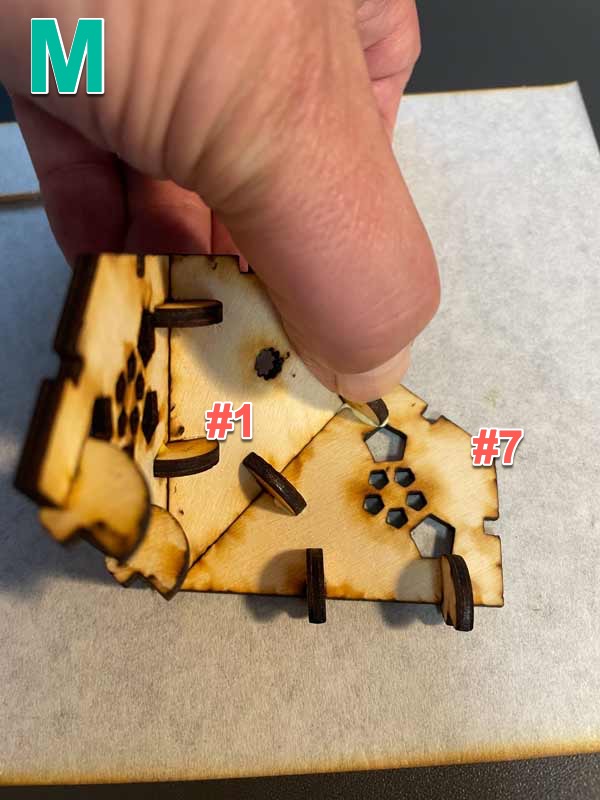
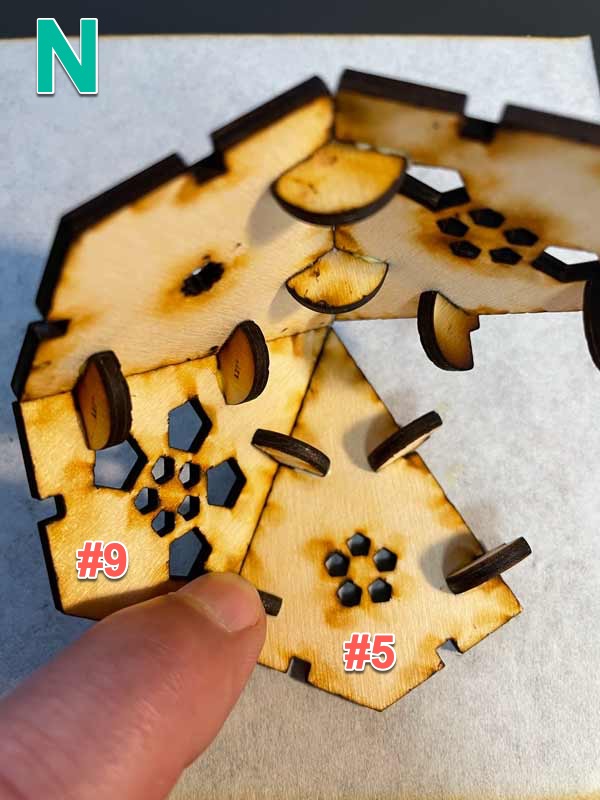
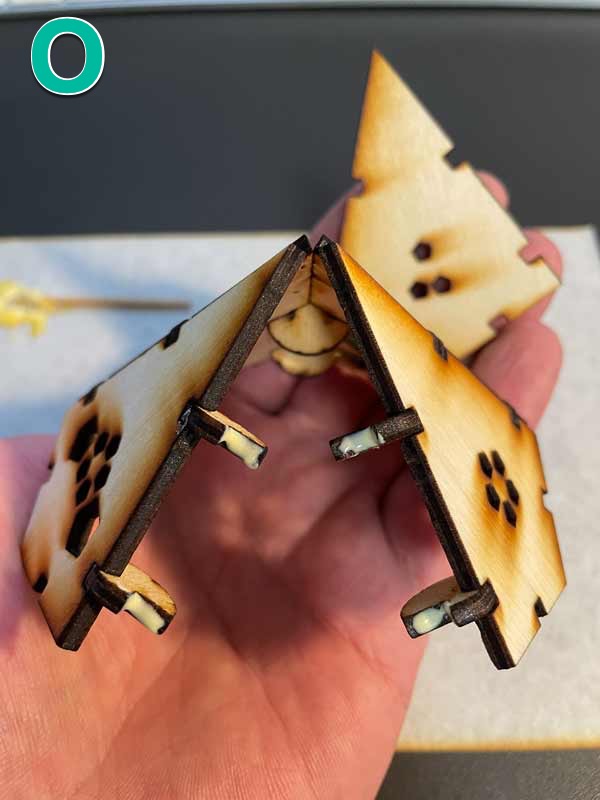
- Apply glue to the 2 joints of face piece #1 you just attached. connect face piece #7 to to #1 as seen in image M above. Laying face piece #7 on your work surface and applying pressure to the joint pieces will make assembly easier. Hold your fingers on the joint pieces against face #7 for 1-2 minutes until set. Allow to dry for 2-3 minutes before continuing.
- Next, apply glue to the left side joint pieces of face piece #9 (where we started). Attach face piece #5 to to #9 as seen in image N above. Laying face piece #5 on your work surface and applying pressure to the joint piece of face #9 (which is already dry) will make assembly easier. Hold your finger in the joint piece against face #5 for 1-2 minutes until set. Allow to dry for 2-3 minutes before continuing.
- Pick up your nearly completed half and apply glue to the 4 joint pieces on the #5 and #7 face pieces as seen in image O above. Attach face piece #3 between face pieces #5 and #7 as seen in image P below. Holding the assembled pieces in your hand will allow you to gently cup the pieces together for a snug fit.
- Your final half of the project should look like image Q below. Set this completed half aside to fully dry.
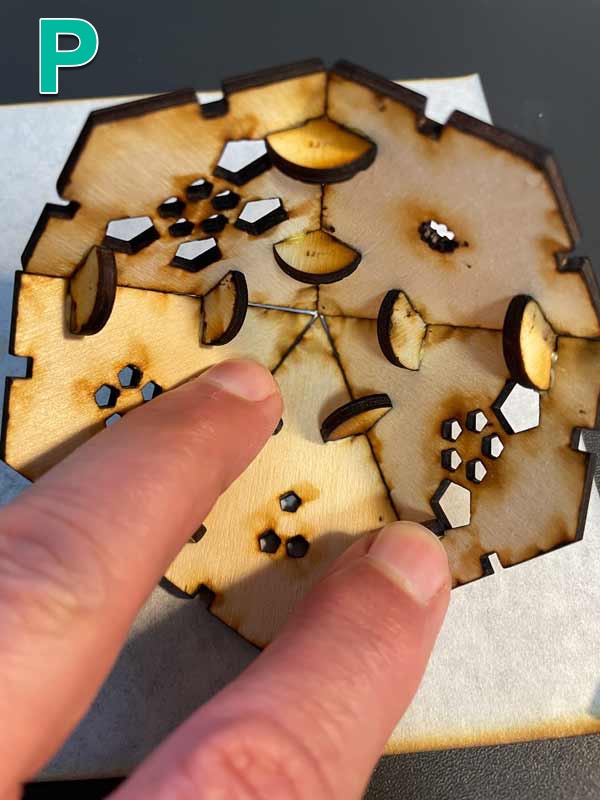
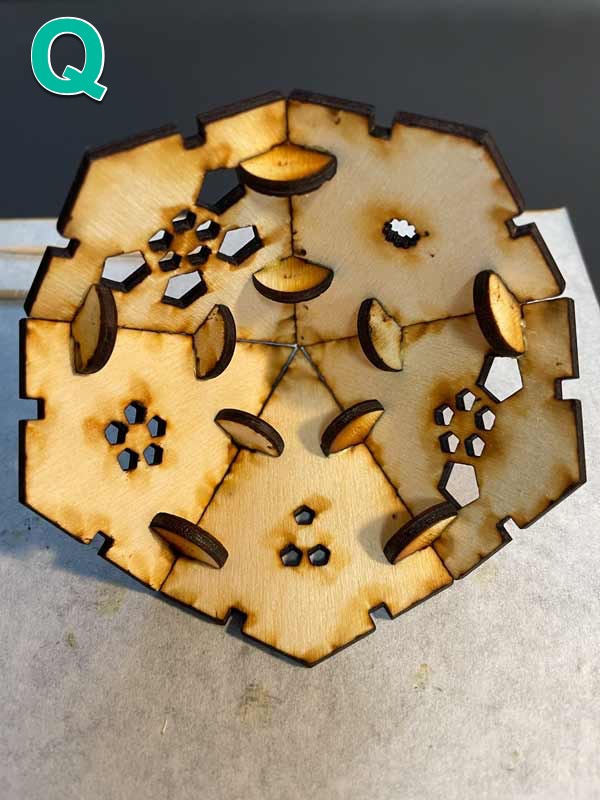
The Final Assembly of the Two Halves!
- Now we finally get to use those small joint pieces. Select the first half you constructed earlier and glue 10 small joint pieces to all of the edges (see image R below). Your first half should now look like image S below. Allow these joints to dry for 3 minutes on the first half.
NOTE: These next few steps will require you to do some prying and nudging of joints to "click" the two completed halves into place. When nudging the joint pieces, make sure to only push them side-to-side and not down, which could pop them out of their slot. Make sure to read the following steps first and have your toothpick or tool ready.
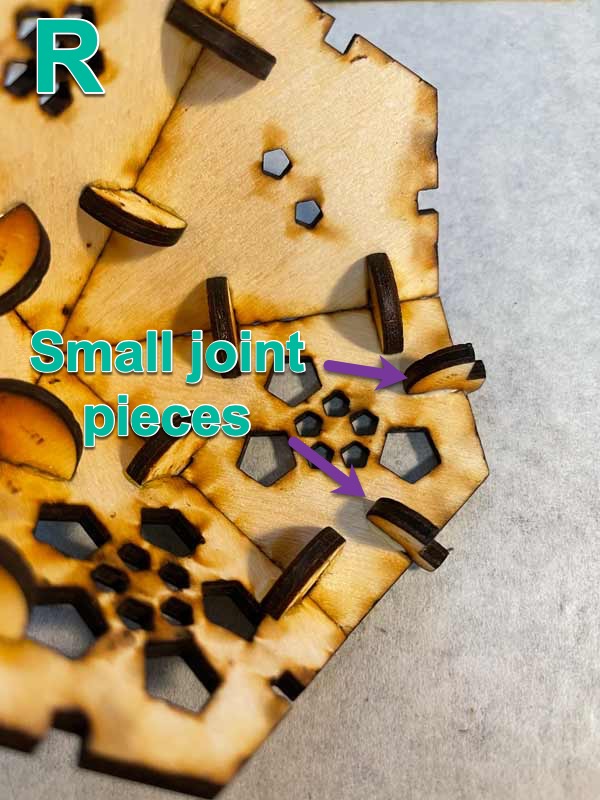
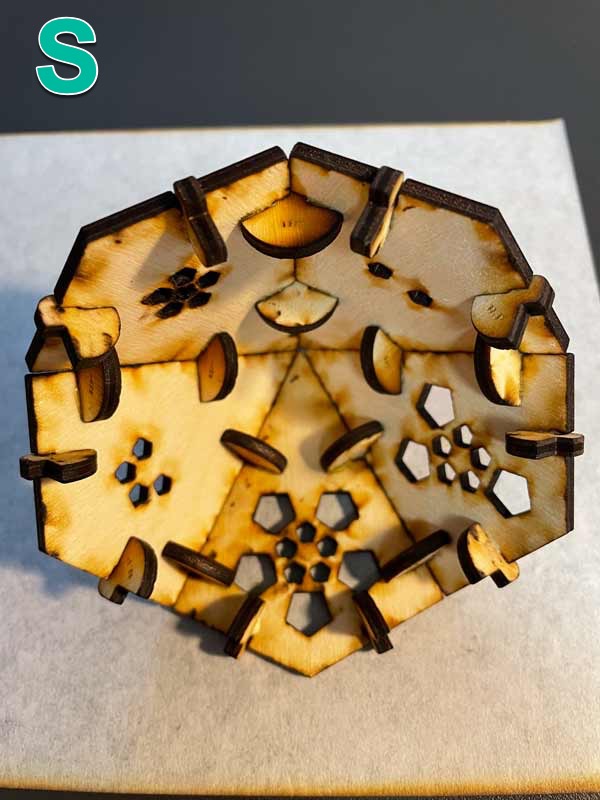
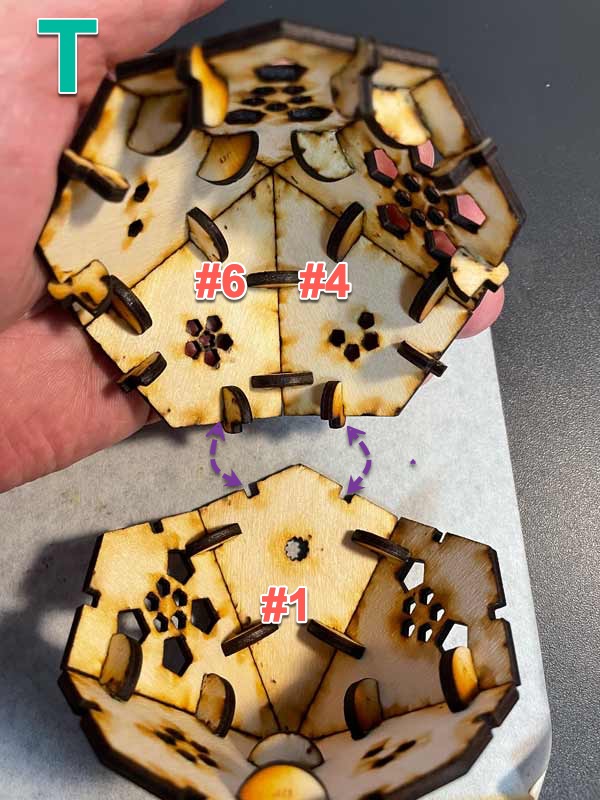
- Apply glue to the 10 joint pieces to the half shown in image S above. Align the two halves on your work surface with face #1 from the second half aligned between faces #4 and #6 of the first half, as seen in image T above. This is where they will be joined.
- Merge the two sides together, lightly pressing to try and nudge the joints on one half into the slots on the other half. Don't force the two sides together as this could cause joint pieces to pop out.
- Use the blunt end of a toothpick or another small tool (screwdriver, letter opener, nail, etc.) to help nudge each joint into its slot as seen in image U below. Remember to only nudge left or right and not downward, which could pop the joint out of its glue. This will take a little fiddling. Continue doing this until all joints are seated in their corresponding slots.
- Once all joints are in place, use your thumb and fingers to lightly squeeze the joined faces together to assure they are well seated (see image V below).
- Your completed polyhedron should look like image W.
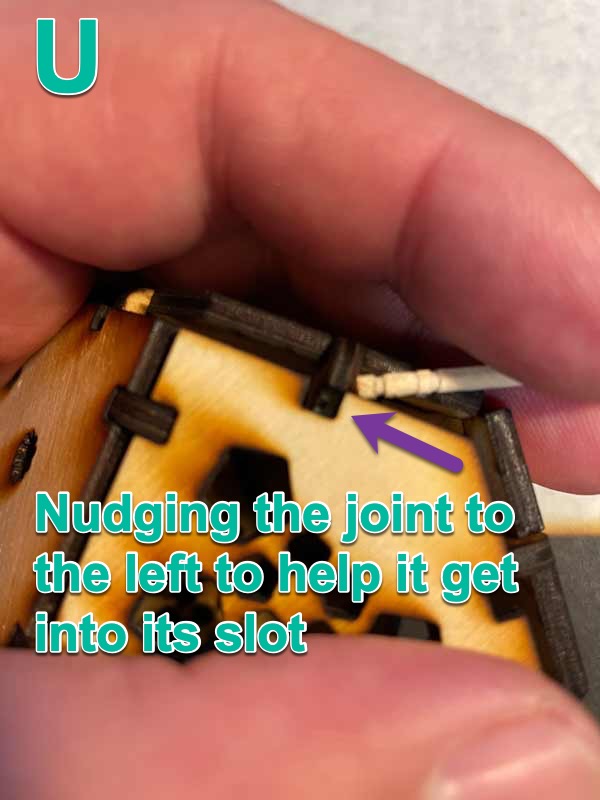
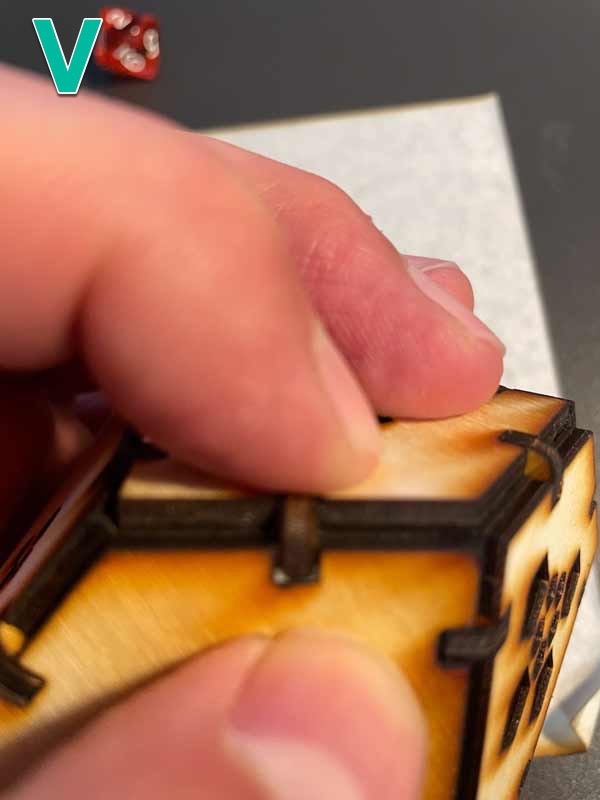
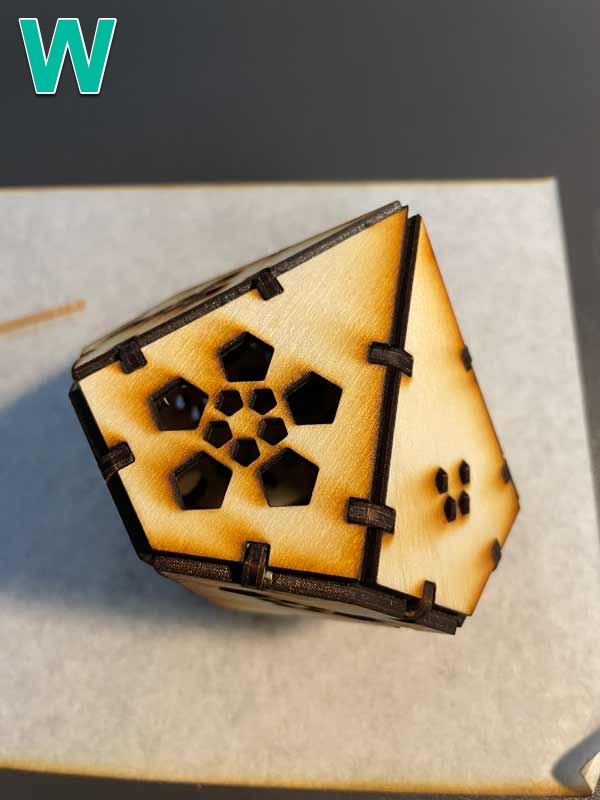
Congratulations! You have a beautiful peice of wood art!
Feel free to apply a light stain or coat with varnish or polyurethane for beauty and strength.